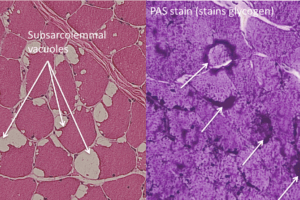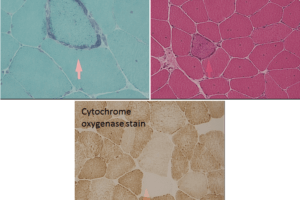Up to 50% of patients with diabetes eventually develop diabetic neuropathy. Poor glycemic control and longer duration of diabetes are most important risk factors for development of neuropathy. The neuropathy can be broadly classified as sensorimotor or autonomic.
Sensorimotor neuropathy
Small nerve fibers, large nerve fibers, nerve roots, and cranial nerves can all be affected and can result in a spectrum of clinical manifestations.
- Distal symmetric polyneuropathy: Is the most commonly encountered neuropathy in diabetic patients. As the name implies, it usually develops insidiously in a bilateral stocking-glove distribution, though the feet are more commonly involved. Pain, paresthesias, numbness constitute some of the sensory symptoms. Motor deficits can lead to muscle weakness and atrophy. Physical exam will show decreased sensation to light touch and pinprick, decreased vibratory and position sense, and reduced or absent achilles reflex. The course of these symptoms is usually progressive.
- Focal mononeuropathy: Has an acute onset and is usually asymmetric. Cranial nerves and peripheral nerves may be involved. CNIII dysfunction usually presents with ptosis, ophthalmoplegia, and diplopia with preserved pupillary function. Peripheral nerves like the median nerve or lateral popliteal nerve may be involved. These neuropathies generally spontaneously resolve in 6-12 months. If some instances, patients may present with more than one nerve palsy at a particular time. This symptom complex is called mononeuropathy multiplex and needs to be distinguished from vasculitis induced mononeuropathy multiplex.
- Diabetic Polyradiculopathy: This disorder can involve nerve roots at the thoracic and high lumbar levels. Patients usually have co-existing distal polyneuropathy. Lumbar polyradiculopathy usually presents acutely with asymmetric lower extremity pain and weakness of the proximal leg- most prominently the thigh muscles. Thoracic polyradiculopathy usually presents with abdominal pain, often in a band like distribution. Weight loss is a frequently associated with this disorder. A high index of suspicion in the right clinical setting (patient with known diabetes), and exclusion of other important diagnoses is required to reach the diagnosis.
Autonomic neuropathy
Can affect the sympathetic, parasympathetic and enteric nerves. Common manifestations include gastroparesis, orthostatic hypotension, bladder dysfunction, and erectile dysfunction.
Reference
Aring, Ann. M.D et al. Evaluation and Prevention of Diabetic Neuropathy. American Family Physician. June 1, 2005; 71(11):2123-2128.



